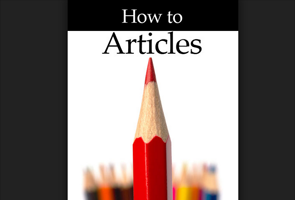Trying to come up with the title for this one wasn’t easy. “How to Write ‘How-to’ Articles” seemed a little choppy, and, in retrospect, I don’t think it would have fit anyway. This isn’t as much a “how to” as it is a “why to,” and that point will become clear as we go.
The how-to theme runs through all kinds of businesses and industries. The most effective uses of it are those that have a good balance of both written and visual content.
Studies have shown that written content with images or video to reinforce it are the most successful in the how-to article arena. They work because they appeal to the widest audience. Some people like written directions, others like maps. Others still like to follow the GPS and gauge how accurate it is.
First, the “Why”
So let’s look at the question directly: Why should you use how-to articles as part of your content marketing strategy? Here are three key reasons.
1. How-to Articles Position You as an Expert
There is no better way to communicate that you know your business than by demonstrating your knowledge of it in your content. Curated content doesn’t work well with how-to articles if your goal is to develop trust with your audience in your ability to deliver whatever service your content covers.
Let your audience hear from YOU. Develop the content yourself. Get help producing it if needs be (that’s what custom writing and media services are for), but show your audience your OWN expertise at work.
2. How-to Articles Put You Directly in Front of Your Target Audience
Most people searching for how-to content already know precisely what they’re looking for, so once they reach your page, they are uniquely positioned to hear and respond to your message. This is a great opportunity for you to fill the immediate need (information) and provide a long-term solution to the problem (your product or service).
3. How-to Articles Are a Great Sales Opportunity
Let’s just use “how to change the oil on your car” as an example. How many products can be sold with that subject between motor oil, oil filters, and other things that people should check at the same time, like air filters, windshield wiper blades, and cleaning products? A how-to article that suggests specific products can be a goldmine if you market those products wisely and correctly.
And Now, the “How”
At this point, though, I think I would be remiss if I didn’t at least give you a how-to section on writing this kind of content. There are plenty of opinions on this subject, but this short list is a great place to start:
1. Choose the Right Title
Don’t mince words here. If you’re writing about how to change your car’s oil, that’s as sophisticated as the title should get: How to Change Your Car’s Oil. Don’t worry about SEO in this instance – the actual content of the page (along with other factors not related to the title) will pick up the slack.
2. Write ONLY about What You Know
Again, don’t curate, and definitely do not
3. Start off Strong
Give your readers a reason to trust your advice. Write a great headline and lead-in paragraph that zero in on the problem and promise a swift and concise solution.
4. List Supplies as Bullet Points
This is especially important if you are trying to sell the products used in the article. If that’s the case, you might even want to hyperlink to the order pages for each product.
5. Write in the Form of Steps, not Text Bricks
Numbering is an effective method here, as it gives the reader a clearly defined progression to follow. You don’t want people searching through paragraphs to find what they need. They won’t tolerate it. They’ll simply go find the information someplace else.
6. Integrate Video or Images in Line with Your Instructions
Paginated or split-post articles work well here, as they isolate the content to the present step in the process without distractions. Definitely consider using this method with your how-to content. It also gives you more opportunities to monetize through ads or product placement.
Finally, don’t underestimate the power of the how-to. Its reach spans virtually every industry and does not need to be tied to physical products. Plenty of people search on subjects like “how to fix your credit” or “how to obtain a no-fault divorce,” too. The opportunities to take advantage of this compelling and practical marketing vehicle are endless and can convert extremely well when used to your best advantage.
